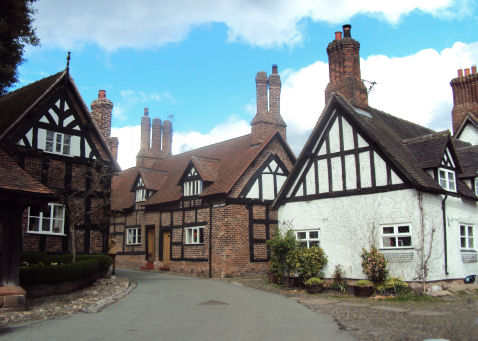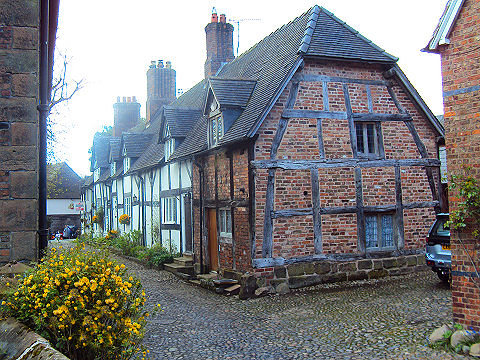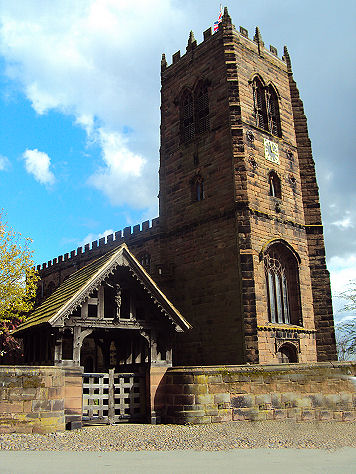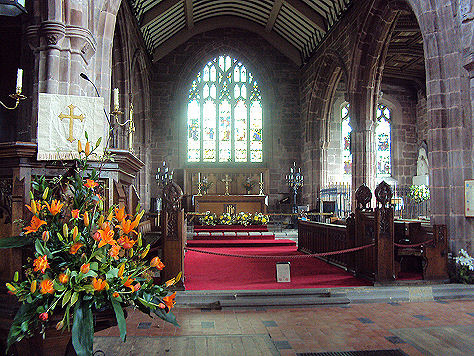Great Budworth
OS grid ref:- SJ6577
The charming village of Great Budworth clusters around the medieval hilltop church of St. Mary's and all Saints. The village owes much of its quaint appearance to the Edgerton-Warburton family of nearby Arley Hall. Until 1948, Great Budworth was part of the Arley Hall estate.

Quaint black and white half timbered houses and seventeenth century red-brick houses line the cobbled pavements of the characterful winding village streets. The village is of ancient origin and is mentioned in the Domesday Book. According to Sir Peter Leycester, the name Great Budworth comes from the Old Saxon words bode ("dwelling") and wurth ("a place by water").

The narrow lane to the left of the village church derives its name from the seventeenth century Smithy and adjoining cottage that can still be seen. Cobbled School Lane which runs alongside the church takes its name from the Jacobean school house with its tiny windows and wooden gables.

The village pub, the George and the Dragon is a handsome building, dates to 1722. It faces the lych gate of the church and around it on a rustic fence are carved the quaint mottoes such as 'Rest all ye nigh aleyard and churchyard, do nought therein beset with sins' and God speed the plough'. Situated three miles from Norwich, Great Budworth was once the largest parish in Cheshire, stretching twenty miles from Warrington to Holmes Chapel in the south.

Near the village lies Marbury Country Park, which prior to its demolition, was the estate of Marbury Hall. The Mere is popular with birdwatchers and is used for a variety of water sports.
St. Mary's Church
The village church of St. Mary's is constructed of warm red sandstone and dates from the fourteenth century. Built maily in the Perpendicular style, it was given to the Priory of Norton by William, Baron of Halton in about 1130.

The interior is impressive, the oldest part of the present church, the Lady Chapel, dates from the fourteenth century; the rest of the church from the fifteenth and sixteenth centuries. Clifton-Taylor includes it in his list of 'best' English parish churches.
The church interior

On the south side stands the small private chapel of the Warburton family, which has an intricately carved tudor ceiling and a heavy oak beam across its entrance. The beam was once part of the nave, but after being replaced was utilised as a roof timber in a nearby farm before being restored to the church and placed in its present position.
The Chancel

The Warburton Chapel contains five oak stalls dating probably from the thirteenth century and considered to be the earliest in Cheshire. The chapel also contains the alabaster effigy of Sir John Warburton who died in 1575.

The font dates back to the fifteenth century. A massive medieval oak chest in the church has four locks, each is only able to be opened by seperate keys held by church officials. In the churchyard is a stone sundial from the late eighteenth century , Just outside the churchyard wall stand the village stocks.
Nearby places of interest
Marbury Country Park once part of a large country estate, the history of the estate stretches back to the thirteenth century. The mere, which is used for watersports, has some excellent views over to Great Budworth church. In the spring the woodland by the mere is awash with a carpet of bluebells and other wildflowers. The woodland contains some impressive and interesting wooden sculptures which have been carved from dead trees.
Arley Hall and Gardens winner of 'Small Visitor Attraction of the Year' at the 2006 Northwest Tourism Awards, is situated near the village of Great Budworth. The Arley estate has been held by the Warburton family since the end of the twelfth century. In 1469 Piers Warburton moved his principal seat from Warburton to Arley, and built the first house to occupy the site.
